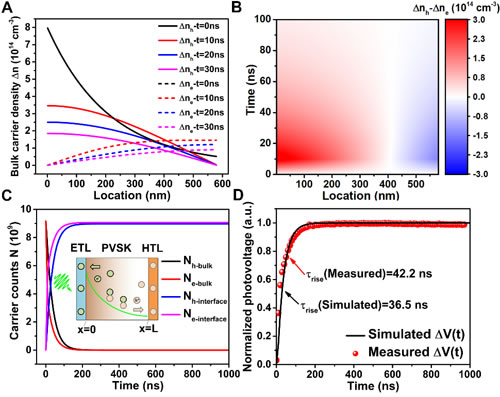Solar cells are photovoltaic devices that convert light energy into electrical energy. In the photoelectric conversion process, the photovoltaic device has undergone multiple bulk phase and interface dynamic processes such as generation, separation, transfer, transport, recombination, extraction of photogenerated charges. These charge dynamics processes essentially dominate the performance of the device itself. How to accurately measure these microscopic dynamic parameters? How to accurately understand the physical mechanism of these dynamic processes? It is an important research topic in the field of optoelectronics and electro-optics. It is also the only way to evaluate material performance and guide device structure optimization to improve device performance. The team of Meng Qingbo, Institute of Physics, Chinese Academy of Sciences / Beijing National Research Center for Condensed Matter Physics has been working on the development of quantitative measurement and analysis methods for physical properties such as charge dynamics and defect states of solar cells while exploring new high-performance thin-film solar cells. A series of research results have been achieved. For example, the successful development of a controllable solar cell transient photoelectric measurement system has achieved the measurement of the charge dynamics of the solar cell under actual working conditions (Rev. Sci. Instrum. 2016, 87, 123107), which has been successfully applied to perovskite solar energy. Measurement of battery ion dynamics (Appl. Phys. Lett. 2015, 107, 163901); quantitative analysis of the interface and bulk defect distribution of solar cells, and used to elucidate the origin of the interface of the electrical stability of perovskite solar cells (Adv. Energy Mater.2019, 9, 1901352). The researchers started from the differential capacitance of photovoltaic devices to study the validity of the theoretical framework of the conventional tailed-state model based on the electrical transient characterization technology, pointing out the consistency of the model in the battery measurement state and the physical process of the solar cell photovoltage generation There are unreasonable assumptions in other aspects, which prove that the theoretical analysis method with tail state model is not universal in solar cell measurement and research. Through theoretical calculation to simulate the carrier dynamics and charge loss mechanism of the device behind the electrical transient characterization technology, they proposed a new theoretical analysis method to quantify the charge loss of the solar cell, which can quantitatively extract photovoltaics from the electrical transient characterization technology The device's charge dynamics quantum efficiency and related defect state information (for example: to quantify the charge extraction and collection quantum efficiency in the device and the defect state density in the absorber layer). This method has good universality for conventional silicon solar cells, emerging copper, zinc, tin, sulfur and solar cells and perovskite solar cells, and can be extended to other photovoltaic devices with similar structures. This work provides an effective way to comprehensively study the carrier dynamics process and charge loss mechanism in solar cells, and has potential application value in other photovoltaic devices. The work, titled Exploiting Electrical Transients to Quantify Charge Loss in Solar Cells, was published in Joule magazine (Joule 4, 472–489). The PhD student Li Yiming and the associate researcher Shi Jiangjian of the Institute of Physics are the co-first authors of the paper, and the researcher Meng Qingbo of the Institute of Physics is the corresponding author of the paper. This research was supported by the National Natural Science Foundation of China, the Chinese Academy of Sciences and the Ministry of Science and Technology.
Hydrofoil
surfboard is like a hydrofoil boat where there is a wing-like structure
underwater that, at speed, lifts the hull above water.The aluminium design is
affordable, robust and stable.
This
technology has entered the world of Stand Up Paddle boarding with the
hydrofoil. The foil insert into the fin box of the bottom of the board, and
once you hit a certain speed, either on a wave, from paddling, or once enough
wind gets trapped under your board, the foil will lift the board and the rider
above the water, providing the rider with a flying sensation.
Foil For Surfboard Sup,Carbon Fiber Hydrofoil,Hydrofoil Carbon Foil,Carbon Hydrofoil Surfboard,Carbon Hydrofoil Board,Hydrofoil Surfboard Foils Huizhou City Melors Plastic Products Co., Limited , https://www.melorsfoam.com
Figure 1. Accurate measurement of device differential capacitance 
Figure 2. Simulation of charge transport in the perovskite absorber layer and establishment of photovoltage 
Figure 3. Electrical transient studies in perovskite solar cells: Device A and B photoelectric conversion efficiency (A) quantifies the charge extraction and collection quantum efficiency (B) and the density of defect states in the perovskite absorber layer (C).
